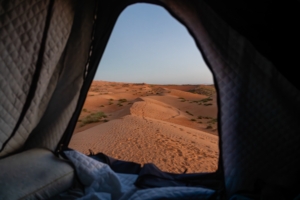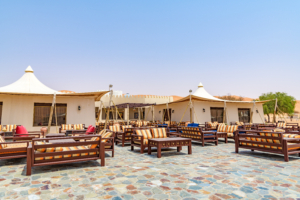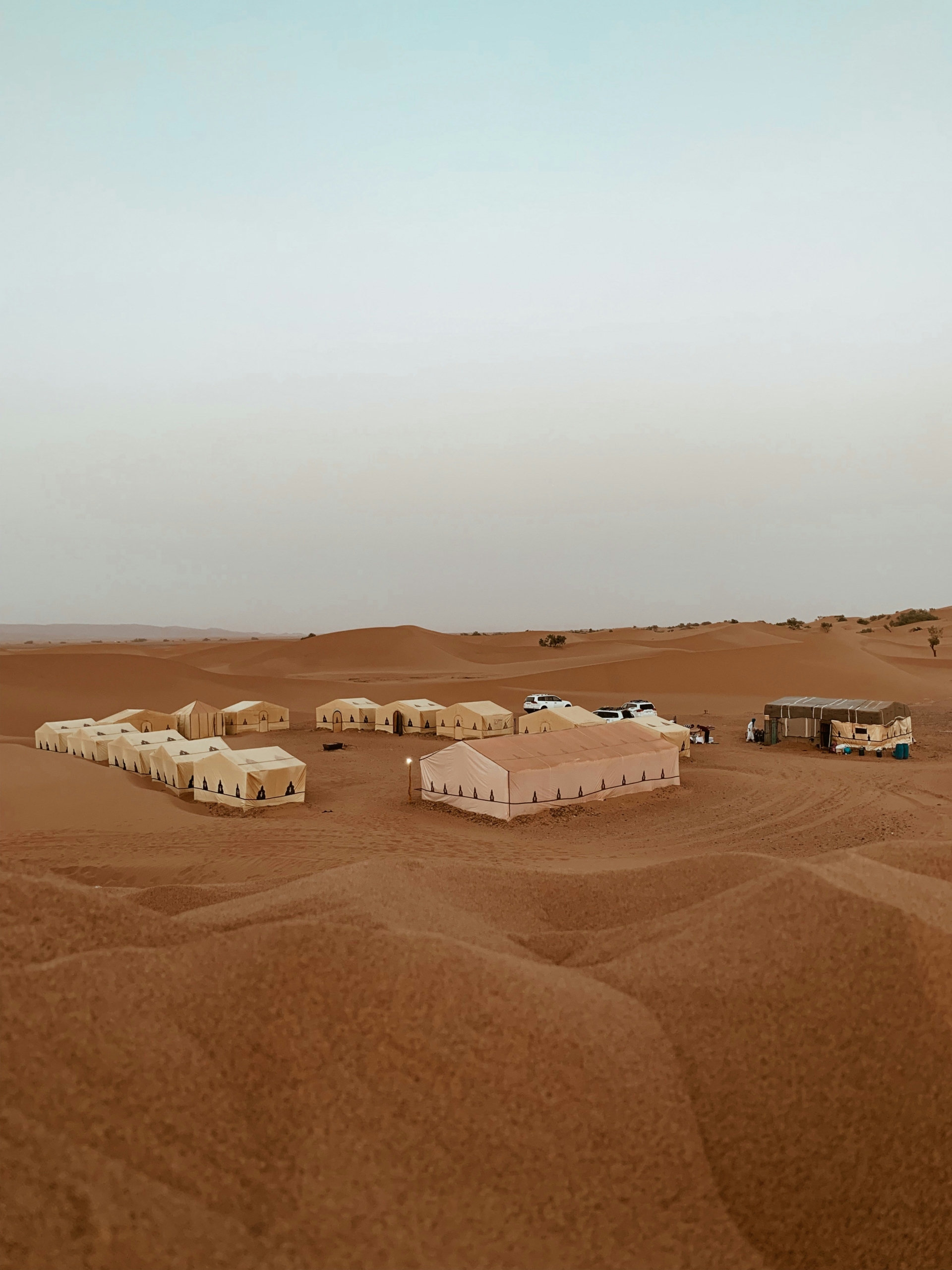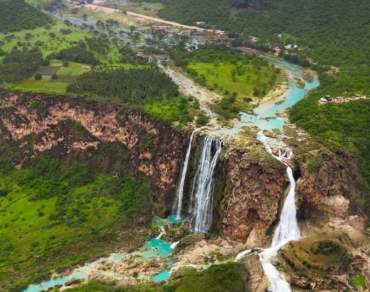The golden sunrise over endless dunes greets you as pristine desert wilderness stretches in every direction. Desert camping in Oman delivers raw adventure mixed with nature’s stunning beauty.
Nights spent under Oman’s starlit desert skies have taught us that this adventure stands apart from any outdoor experience. Each trip to the magnificent Wahiba Sands and remote desert camps brings new findings and moments you’ll never forget.
This piece walks you through planning your desert camping trip in Oman. You’ll learn about the right gear, route planning, vehicle preparation, survival skills, weather patterns, and local rules that make your desert adventure safe and memorable.
Essential Desert Camping Gear for Oman
Desert camping in Oman becomes an exceptional adventure with the right gear. The difference between an amazing experience and a tough ordeal lies in what you pack. Let me break down everything you need to stay safe and comfortable.
 Weather-appropriate clothing and protection
Weather-appropriate clothing and protection
The desert’s extreme temperature swings just need strategic clothing choices. Our expeditions show how temperatures drop significantly at night, even after hot days. Here’s what works best:
- Base Layers: Lightweight, moisture-wicking materials
- Outer Layers: Warm jacket and socks for winter evenings
- Protection: Sun hat, sunglasses, and high-SPF sunscreen
- Desert Essentials: Large scarf or shemagh to protect your face
Camping equipment and shelter essentials
Quality shelter and sleeping gear are non-negotiable based on our desert camping experience. Sleeping under the stars feels magical, but a reliable tent gives you the backup you need. Your essential camping equipment should include:
| Category |
Must-Have Items |
| Shelter |
Sturdy tent or rooftop tent |
| Sleep System |
Sleeping bag, camp bed/mat |
| Comfort |
Camping chairs, LED lights |
| Kitchen |
Camping stove, cookware set |
Navigation and safety tools
Proper navigation and safety equipment are vital for desert ventures. Navigation is a significant skill to master for desert exploration. These items are essential:
-
- GPS device with desert maps
A complete first aid kit with electrolyte tablets and antiseptic lotion stays in our pack. Remote areas with spotty mobile coverage make a satellite phone invaluable. Keep emergency gear available and check that everything works properly.
Note that water is crucial – pack at least three liters per person daily. A quality cooler with ice packs keeps supplies fresh longer. We add a small towel on top for extra insulation.
Planning Your Desert Route
Our years in Oman’s deserts have taught us that good desert camping begins with smart route planning. Let me share everything we know about planning your desert adventure.
Best entry points to the Wahiba Sands
Wahiba Sands covers 12,500 square kilometers, with several ways to enter this vast desert. Al Mintirib stands out as the simplest entry point, particularly if you’re new to desert camping. The desert lies about two and a half hours from Muscat, which makes it ideal for weekend trips.
Here’s our tested route guide:
| Starting Point |
Travel Time |
Notes |
| Muscat |
2.5 hours |
Most common route |
| Sur |
2 hours |
Coastal approach |
| Nizwa |
2 hours |
Mountain route |
Choosing camping locations
The western side of the dunes works best for beginners. You’ll find the first mile of sand track well-packed, which makes driving easier. For supplies and services:
- Al Wasil and Bidiyah offer tire inflation/deflation services
- Ibra (20km away) has a large Lulu’s Hypermarket
- Al Barwani petrol station provides simple supplies
 Understanding desert terrain
Understanding desert terrain
Wahiba’s terrain stands unique and needs careful guidance. The dunes stretch north to south in regular valleys that reach up to 100 meters high. The dunes peak near the ocean to the east and gradually lower as you head west.
The southern dunes need extra attention because of their salt flats. The landscape’s ever-changing nature amazes us – these massive dunes shift up to 10 meters each year, constantly changing the terrain.
We use the permanent tracks that run through the valleys between dunes. These paths stay well-packed thanks to regular tourists and local traffic. The desert’s 4,800 square miles give us plenty of room to find quiet, secluded camping spots.
Important Safety Note: Don’t try crossing Wahiba Sands north to south without a guide. The dunes can be tricky, and getting lost or stuck happens more often than you’d think. If desert driving makes you nervous, stick to camping near the front dunes. You’ll still experience Oman’s desert magic without tackling the challenging terrain.
Vehicle Preparation and Safety
Our experience organizing desert expeditions has taught us that proper vehicle preparation can determine the success of your Oman desert camping adventure. Let’s head over to the significant aspects of getting your vehicle desert-ready.
4×4 requirements and modifications
Our countless desert adventures have proven that a proper 4×4 vehicle isn’t just recommended – it’s mandatory. Many locations in Oman, including Wahiba Sands, require 4WD vehicles. Checkpoints will stop you if you don’t have one. Toyota Fortuner, Nissan Patrol, or Land Rover Discovery are our recommended vehicles, as standard AWD vehicles aren’t enough.
Tire pressure management
Tire pressure management is vital to desert driving success. Here’s our tested pressure guide:
| Terrain Type |
Recommended PSI |
Purpose |
| Normal Roads |
35-37 |
Regular driving |
| Desert Entry |
15-18 |
Original sand driving |
| Soft Sand |
10-12 |
Emergencies |
We reduce our tire pressure to around 15-18 PSI before entering the desert. This increases the tire’s contact patch by up to 25% and helps the vehicle “float” on the sand rather than cut through it. Note that going below 10 PSI risks damaging your rims or the tire.
Emergency vehicle kit essentials
Our desert expeditions have helped us create a detailed emergency kit that has proven invaluable. Essential items:
-
- First aid kit with tourniquet and electrolytes
-
- Fully charged satellite phone for remote areas
-
- Police-type whistle and signal mirror
-
- Solar battery pack for device charging
-
- Sand ladders and a shovel
-
- Simple tool kit with screwdrivers and pliers
The vehicle’s tank should be full before entering the desert. We carry additional fuel in jerry cans for remote areas. Our experience shows you should never let your fuel tank drop below half full when desert camping in Oman.
Your traction control should be off before hitting the dunes – this prevents wheel spinning that could dig you deeper into the sand. The vehicle’s side airbags should be turned off as the dune angles can trigger false deployments.
 Desert Survival Skills
Desert Survival Skills
Our desert expeditions in Oman have taught us that survival skills matter just as much as having the right gear. Let me share some vital skills that kept us safe during countless nights in the desert.
Water management and hydration
Water means everything in the desert – it’s life itself. Local Bedouins taught us that wells are so precious, they name them after the people who find them. Experience shows we need at least 20 liters of water per person daily, split this way:
| Purpose |
Daily Requirement |
| Drinking |
5 liters |
| Cooking/Cleaning |
10 liters |
| Emergency Reserve |
5 liters |
Proper hydration goes beyond just water – maintaining salt levels is vital too. We pack electrolyte tablets and drink water regularly throughout the day, even without feeling thirsty.
Navigation techniques
Traditional navigation skills are a great backup when modern technology fails in the Wahiba Sands. The dunes move constantly, which makes permanent roads impossible. We’ve become skilled at several reliable navigation methods:
- Natural Indicators: Wind-shaped plants and a crescent moon pointing south guide us
- Celestial Navigation: The ‘Navigator’s Triangle’ and the Cygnus constellation help us find true north
- Traditional Tools: A ‘kamal,’ an ancient instrument used by early desert travelers, comes in handy
Emergency protocols
Desert camping over the years has taught us to prepare for all kinds of emergencies. Our complete safety system includes:
Communication Protocol:
- A trusted contact gets our detailed travel plans
- Satellite phones work in areas without coverage
- The group uses pre-arranged emergency signals
Shelter and shade become top priorities during emergencies. Vehicle interiors can hit 160°F in extreme heat, so proper shelter is essential. Mylar blankets provide emergency shade, and we keep first aid supplies within easy reach.
Scorpions show up more often in winter as they look for warmth. We check our tents and equipment carefully. Local Bedouins have passed down their knowledge of handling these challenges through generations.
Staying aware of your surroundings works best as a defense. We track our water use, keep talking within our group, and watch for weather changes closely. Our time in Oman’s deserts shows that survival needs more than just skills – it’s about understanding and respecting this unique place.
Weather Considerations
Our years of camping in Oman’s deserts have shown us how the weather shapes every adventure. Let’s look at the vital weather patterns and plan a safe desert experience.
Best seasons for desert camping
The right timing makes all the difference for desert camping in Oman. We’ve found the sweet spot runs from October to April. These months bring such comfortable temperatures that camping becomes a real joy.
Winter months give us the best conditions:
- Daytime temperatures: Moderate 25-30°C
- Night temperatures: Can drop to 12°C
- Humidity levels: Generally low and comfortable
 Understanding desert climate patterns
Understanding desert climate patterns
Oman’s desert climate shows amazing extremes that we’ve grown to respect. The Wahiba Sands have a hyper-arid desert climate, and monsoon systems shape their patterns. Summer temperatures climb above 40°C, which makes camping very difficult.
Our temperature readings show:
| Season |
Day Temperature |
Night Temperature |
Camping Suitability |
| Winter (Oct-Mar) |
28°C |
12-15°C |
Excellent |
| Summer (May-Sep) |
40°C+ |
25-30°C |
Not Recommended |
Desert temperatures swing dramatically. We’ve seen Fahud hit 30.5°C while Jabal Shams drops to 6.2°C. These changes create unique microclimates that guide where we camp.
Dealing with sandstorms
Sandstorms need serious attention, especially in the summer months. The Shamal winds pack quite a punch. These storms can cut visibility to zero, with winds reaching 93-109 kilometers per hour.
Here’s our sandstorm survival plan:
Before the storm:
- Check weather forecasts regularly
- Place the camp between the dunes for protection
- Secure all gear properly
During the storm:
- Stay sheltered
- Pointing vehicles away from the wind
- Keep radio or satellite communication working
The summer Al-Bawareh winds hit the eastern Arabian Peninsula hard. We always study seasonal wind patterns before planning trips. Winds pick up most afternoons in Wahiba, so we set up camp and do activities early.
Our desert camping experience in Oman proves that knowing these weather patterns helps us survive and thrive. The desert climate supports tough plants and animals. We’ve learned to camp safely by respecting nature’s rhythms and admiring how desert life adapts.
Local Regulations and Permits
Our years of directing desert campers through Oman’s regulations taught us that local rules matter just as much as your sand-driving skills. This guide will help you keep your desert adventure legal and respectful.
Camping permissions and restrictions
Oman’s camping rules have changed substantially, especially in the Muscat Governorate. Wild camping remains allowed across Oman, but specific rules apply:
Any stay longer than 48 hours requires a permit with these requirements:
- Security deposit
- License duration: 7 days (renewable)
- Clear display of the license number at the campsite
Here’s what you need to know about camping rules:
| Regulation Type |
Requirement |
Penalty |
| Unauthorized Camping |
Permit needed beyond 48 hours |
RO 200 fine |
| Distance Requirements |
100m from residential areas |
RO 50 fine |
| Duration Limit |
48 hours without a permit |
Immediate removal |
Environmental Protection Guidelines
Our desert trips showed us why protecting Oman’s delicate desert ecosystem matters. Local authorities enforce strict environmental rules that we always follow:
Waste Management Protocol:
- The “Leave No Trace” principle is mandatory
- Use only biodegradable products
- Pack out all trash and waste materials
Fire management needs extra attention. Rules state:
- Use only established fire pits
- Completely extinguish fires
- No fires in green areas or beach lands
Site modifications face strict prohibitions. Guidelines clearly state:
- No heavy machinery for leveling
- No dirt barriers
- No changes to the natural environment
- No concrete or permanent materials
Cultural considerations
Bedouin communities welcome visitors warmly, and respecting their traditions enriches everyone’s experience. These practices help maintain good relationships:
Dress Code and Behavior:
- Men: Knee-length or longer shorts
- Women: Loose clothing covering shoulders and legs
- Modest attire even in remote locations
Prayer times deserve respect. We stay quiet during the five daily prayer times. This small gesture creates positive interactions with local communities.
Near Bedouin settlements, these protocols matter:
- Ask before taking photos of people or homes
- Buy local handicrafts when possible
- Join cultural experiences respectfully
Local hospitality amazes us. People often invite us for coffee and dates when we ask to camp near their area. Still, we maintain a 100-meter distance from private properties and homes as rule.
Supporting tours and camps that partner with Bedouin communities helps preserve cultural heritage. This approach makes trips more meaningful.
Note that while Oman allows wild camping, some areas remain off-limits:
- Private land
- Protected nature reserves
- Turtle nesting beaches at Ras Al Jinz
- Wadi beds (for safety reasons)
Conclusion
Desert camping in Oman creates adventures that last a lifetime. Our years in the field have taught us that success depends on careful preparation – from choosing the right gear to understanding local traditions. Wahiba Sands calls adventurers with its golden dunes and starlit skies. Yet it just needs respect through proper vehicle preparation, survival skills, and weather awareness.
The best desert experiences emerge from a careful balance of adventure and safety. A solid foundation of proper planning includes route selection, water management, and following local rules. These elements create unforgettable camping trips. The desert’s harsh conditions command our deepest respect, and its Bedouin communities provide great lessons about living in harmony with this striking environment.
Desert camping goes beyond mastering tough terrain – it lets us dive deep into one of Oman’s natural treasures. The desert gives us experiences beyond comparison if we follow proper protocols and honor both the environment and local culture.
Explore this adventure and book now! 

 Weather-appropriate clothing and protection
The desert’s extreme temperature swings just need strategic clothing choices. Our expeditions show how temperatures drop significantly at night, even after hot days. Here’s what works best:
Weather-appropriate clothing and protection
The desert’s extreme temperature swings just need strategic clothing choices. Our expeditions show how temperatures drop significantly at night, even after hot days. Here’s what works best:
 Understanding desert terrain
Wahiba’s terrain stands unique and needs careful guidance. The dunes stretch north to south in regular valleys that reach up to 100 meters high. The dunes peak near the ocean to the east and gradually lower as you head west.
The southern dunes need extra attention because of their salt flats. The landscape’s ever-changing nature amazes us – these massive dunes shift up to 10 meters each year, constantly changing the terrain.
We use the permanent tracks that run through the valleys between dunes. These paths stay well-packed thanks to regular tourists and local traffic. The desert’s 4,800 square miles give us plenty of room to find quiet, secluded camping spots.
Important Safety Note: Don’t try crossing Wahiba Sands north to south without a guide. The dunes can be tricky, and getting lost or stuck happens more often than you’d think. If desert driving makes you nervous, stick to camping near the front dunes. You’ll still experience Oman’s desert magic without tackling the challenging terrain.
Vehicle Preparation and Safety
Our experience organizing desert expeditions has taught us that proper vehicle preparation can determine the success of your Oman desert camping adventure. Let’s head over to the significant aspects of getting your vehicle desert-ready.
4×4 requirements and modifications
Our countless desert adventures have proven that a proper 4×4 vehicle isn’t just recommended – it’s mandatory. Many locations in Oman, including Wahiba Sands, require 4WD vehicles. Checkpoints will stop you if you don’t have one. Toyota Fortuner, Nissan Patrol, or Land Rover Discovery are our recommended vehicles, as standard AWD vehicles aren’t enough.
Tire pressure management
Tire pressure management is vital to desert driving success. Here’s our tested pressure guide:
Understanding desert terrain
Wahiba’s terrain stands unique and needs careful guidance. The dunes stretch north to south in regular valleys that reach up to 100 meters high. The dunes peak near the ocean to the east and gradually lower as you head west.
The southern dunes need extra attention because of their salt flats. The landscape’s ever-changing nature amazes us – these massive dunes shift up to 10 meters each year, constantly changing the terrain.
We use the permanent tracks that run through the valleys between dunes. These paths stay well-packed thanks to regular tourists and local traffic. The desert’s 4,800 square miles give us plenty of room to find quiet, secluded camping spots.
Important Safety Note: Don’t try crossing Wahiba Sands north to south without a guide. The dunes can be tricky, and getting lost or stuck happens more often than you’d think. If desert driving makes you nervous, stick to camping near the front dunes. You’ll still experience Oman’s desert magic without tackling the challenging terrain.
Vehicle Preparation and Safety
Our experience organizing desert expeditions has taught us that proper vehicle preparation can determine the success of your Oman desert camping adventure. Let’s head over to the significant aspects of getting your vehicle desert-ready.
4×4 requirements and modifications
Our countless desert adventures have proven that a proper 4×4 vehicle isn’t just recommended – it’s mandatory. Many locations in Oman, including Wahiba Sands, require 4WD vehicles. Checkpoints will stop you if you don’t have one. Toyota Fortuner, Nissan Patrol, or Land Rover Discovery are our recommended vehicles, as standard AWD vehicles aren’t enough.
Tire pressure management
Tire pressure management is vital to desert driving success. Here’s our tested pressure guide:
 Desert Survival Skills
Our desert expeditions in Oman have taught us that survival skills matter just as much as having the right gear. Let me share some vital skills that kept us safe during countless nights in the desert.
Water management and hydration
Water means everything in the desert – it’s life itself. Local Bedouins taught us that wells are so precious, they name them after the people who find them. Experience shows we need at least 20 liters of water per person daily, split this way:
Desert Survival Skills
Our desert expeditions in Oman have taught us that survival skills matter just as much as having the right gear. Let me share some vital skills that kept us safe during countless nights in the desert.
Water management and hydration
Water means everything in the desert – it’s life itself. Local Bedouins taught us that wells are so precious, they name them after the people who find them. Experience shows we need at least 20 liters of water per person daily, split this way:
 Understanding desert climate patterns
Oman’s desert climate shows amazing extremes that we’ve grown to respect. The Wahiba Sands have a hyper-arid desert climate, and monsoon systems shape their patterns. Summer temperatures climb above 40°C, which makes camping very difficult.
Our temperature readings show:
Understanding desert climate patterns
Oman’s desert climate shows amazing extremes that we’ve grown to respect. The Wahiba Sands have a hyper-arid desert climate, and monsoon systems shape their patterns. Summer temperatures climb above 40°C, which makes camping very difficult.
Our temperature readings show:
 Weather-appropriate clothing and protection
The desert’s extreme temperature swings just need strategic clothing choices. Our expeditions show how temperatures drop significantly at night, even after hot days. Here’s what works best:
Weather-appropriate clothing and protection
The desert’s extreme temperature swings just need strategic clothing choices. Our expeditions show how temperatures drop significantly at night, even after hot days. Here’s what works best:
 Understanding desert terrain
Wahiba’s terrain stands unique and needs careful guidance. The dunes stretch north to south in regular valleys that reach up to 100 meters high. The dunes peak near the ocean to the east and gradually lower as you head west.
The southern dunes need extra attention because of their salt flats. The landscape’s ever-changing nature amazes us – these massive dunes shift up to 10 meters each year, constantly changing the terrain.
We use the permanent tracks that run through the valleys between dunes. These paths stay well-packed thanks to regular tourists and local traffic. The desert’s 4,800 square miles give us plenty of room to find quiet, secluded camping spots.
Important Safety Note: Don’t try crossing Wahiba Sands north to south without a guide. The dunes can be tricky, and getting lost or stuck happens more often than you’d think. If desert driving makes you nervous, stick to camping near the front dunes. You’ll still experience Oman’s desert magic without tackling the challenging terrain.
Vehicle Preparation and Safety
Our experience organizing desert expeditions has taught us that proper vehicle preparation can determine the success of your Oman desert camping adventure. Let’s head over to the significant aspects of getting your vehicle desert-ready.
4×4 requirements and modifications
Our countless desert adventures have proven that a proper 4×4 vehicle isn’t just recommended – it’s mandatory. Many locations in Oman, including Wahiba Sands, require 4WD vehicles. Checkpoints will stop you if you don’t have one. Toyota Fortuner, Nissan Patrol, or Land Rover Discovery are our recommended vehicles, as standard AWD vehicles aren’t enough.
Tire pressure management
Tire pressure management is vital to desert driving success. Here’s our tested pressure guide:
Understanding desert terrain
Wahiba’s terrain stands unique and needs careful guidance. The dunes stretch north to south in regular valleys that reach up to 100 meters high. The dunes peak near the ocean to the east and gradually lower as you head west.
The southern dunes need extra attention because of their salt flats. The landscape’s ever-changing nature amazes us – these massive dunes shift up to 10 meters each year, constantly changing the terrain.
We use the permanent tracks that run through the valleys between dunes. These paths stay well-packed thanks to regular tourists and local traffic. The desert’s 4,800 square miles give us plenty of room to find quiet, secluded camping spots.
Important Safety Note: Don’t try crossing Wahiba Sands north to south without a guide. The dunes can be tricky, and getting lost or stuck happens more often than you’d think. If desert driving makes you nervous, stick to camping near the front dunes. You’ll still experience Oman’s desert magic without tackling the challenging terrain.
Vehicle Preparation and Safety
Our experience organizing desert expeditions has taught us that proper vehicle preparation can determine the success of your Oman desert camping adventure. Let’s head over to the significant aspects of getting your vehicle desert-ready.
4×4 requirements and modifications
Our countless desert adventures have proven that a proper 4×4 vehicle isn’t just recommended – it’s mandatory. Many locations in Oman, including Wahiba Sands, require 4WD vehicles. Checkpoints will stop you if you don’t have one. Toyota Fortuner, Nissan Patrol, or Land Rover Discovery are our recommended vehicles, as standard AWD vehicles aren’t enough.
Tire pressure management
Tire pressure management is vital to desert driving success. Here’s our tested pressure guide:
 Desert Survival Skills
Our desert expeditions in Oman have taught us that survival skills matter just as much as having the right gear. Let me share some vital skills that kept us safe during countless nights in the desert.
Water management and hydration
Water means everything in the desert – it’s life itself. Local Bedouins taught us that wells are so precious, they name them after the people who find them. Experience shows we need at least 20 liters of water per person daily, split this way:
Desert Survival Skills
Our desert expeditions in Oman have taught us that survival skills matter just as much as having the right gear. Let me share some vital skills that kept us safe during countless nights in the desert.
Water management and hydration
Water means everything in the desert – it’s life itself. Local Bedouins taught us that wells are so precious, they name them after the people who find them. Experience shows we need at least 20 liters of water per person daily, split this way:
 Understanding desert climate patterns
Oman’s desert climate shows amazing extremes that we’ve grown to respect. The Wahiba Sands have a hyper-arid desert climate, and monsoon systems shape their patterns. Summer temperatures climb above 40°C, which makes camping very difficult.
Our temperature readings show:
Understanding desert climate patterns
Oman’s desert climate shows amazing extremes that we’ve grown to respect. The Wahiba Sands have a hyper-arid desert climate, and monsoon systems shape their patterns. Summer temperatures climb above 40°C, which makes camping very difficult.
Our temperature readings show:



